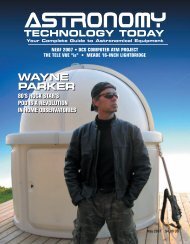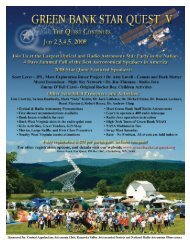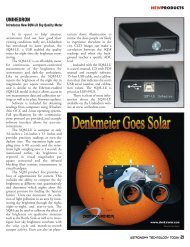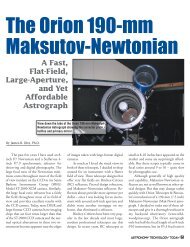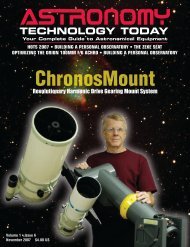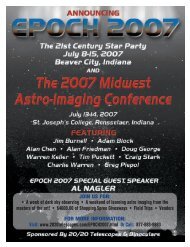magnilux - Astronomy Technology Today
magnilux - Astronomy Technology Today
magnilux - Astronomy Technology Today
You also want an ePaper? Increase the reach of your titles
YUMPU automatically turns print PDFs into web optimized ePapers that Google loves.
FIELD TESTING THE TMB-92L SIGNATURE SERIES F/5.5<br />
Image 2 - The Andromeda galaxy imaged with a Hutech-modified Canon 50D and the<br />
TMB-92L f/5.5 equipped with an AstroTech field flattener.<br />
Image 3 - Close-up of the four corners of Image 2<br />
before his untimely death in 2007. His<br />
outstanding TMB-130 f/7 has been available<br />
for several years and is a fine performer<br />
in its own right. For details, see<br />
my review in ATT Volume 2, #5, 2008. I<br />
now use both telescopes mounted piggy<br />
back, alternately for imaging and as guide<br />
scopes (see Image 1).<br />
Visual Performance<br />
Due to its short f-ratio and 506-mm<br />
focal length, the TMB-92L is an ideal<br />
“richest-field” telescope. It provides an<br />
eye-popping 4-degree actual field of view<br />
with a 26-mm Nagler, 3.7 degrees with a<br />
23-mm Axiom and around 3 degrees<br />
with a 22-mm Panoptic. In short, it fully<br />
frames extended objects like the<br />
Andromeda galaxy, the Pleiades, the<br />
Rosette nebula and the North America<br />
complex, to name a few. Moreover,<br />
thanks to this little scope’s incredible<br />
high contrast, under really dark, transparent<br />
skies, many of these objects stand<br />
out in sharp contrast against the<br />
background giving an almost 3-D like<br />
appearance.<br />
While I expected good deep-sky<br />
performance from the TMB-92L, I was<br />
astounded by how well it also performs<br />
on the moon and planets. Even a bright<br />
gibbous moon showed no detectable<br />
chromatic aberration. Under low power,<br />
the moon too provided stunning views of<br />
a world suspended in space. With higher<br />
magnification, numerous craterlets<br />
popped into view inside major basins like<br />
Ptolemaeus and Clavius.<br />
The biggest surprise, though, was the<br />
remarkable high-power views the<br />
TMB-92L provided of Jupiter. Using an<br />
older, 2.5-mm Orion Lanthanum-series<br />
eyepiece at 200x on a night of very good<br />
seeing, Jupiter’s cloud bands and the<br />
currently rather faint Red Spot stood out<br />
in remarkably sharp contrast and subtle<br />
colors. This is truly impressive performance<br />
by a pocket-size telescope of less<br />
than 4 inches in aperture.<br />
Imaging Performance<br />
My main reason for obtaining the<br />
TMB-92L was for imaging with my<br />
Hutech-modified Canon DSLR. I<br />
wanted something in the 500-mm focallength<br />
range, with “fast” optics and widefield<br />
capabilities to supplement my<br />
longer-focal-length telescopes and to<br />
serve as potential guide scope for an<br />
Orion StarShoot auto guider. I have not<br />
been disappointed.<br />
Like all fast apochromatic refractors<br />
42 <strong>Astronomy</strong> TECHNOLOGY TODAY



